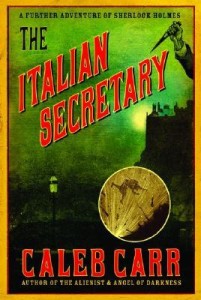Included below is a synopsis of Caleb Carr’s fifth novel, The Italian Secretary: A Further Adventure of Sherlock Holmes, which was published by Carroll & Graf in 2005. Selected critical reception has also been included. For summaries and selected critical reception of Caleb Carr’s other fiction and non-fiction works, please use the menu.
The Italian Secretary Summary
Publisher’s Blurb
Caleb Carr’s newest tale (commissioned by the estate of Sir Arthur Conan Doyle) begins when Sherlock Holmes reveals to Dr. Watson an encrypted telegram he has received from his brother Mycroft; the famous detective has been summoned to the aid of Queen Victoria in Scotland. Rushed northward on a royal train–and nearly murdered themselves en route–Holmes and Watson are soon joined by Mycroft, and learn of the brutal killings of a renowned architect and his foreman, both of whom had been preparing to renovate a wing of the famous and forbidding Royal Palace of Holyrood, in Edinburgh.
Mycroft has enlisted his brother to help solve the murders that may be key elements of a much more elaborate and pernicious plot on the Queen’s life. But the circumstances of the two victims’ deaths also call to Holmes’s mind the terrible murder–in the palace of Holyrood–of “The Italian Secretary,” David Rizzio. The only difficulty? Rizzio, a music teacher and confidante of Mary, Queen of Scots, was butchered before Mary’s very eyes three centuries earlier by supporters of England’s Queen Elizabeth (and perhaps with the approval of that uncompromising ruler herself) in an attempt to break the spirit of the very independent young Scottish Queen.
Holmes proceeds to alarm Watson with the suggestion that the Italian Secretary’s vengeful spirit may have taken the lives of the two men as punishment for disturbing the scene of his assassination. Will these two new deaths turn out to be mere coincidence? Have old political rivalries reared their poisonous heads once again? Or has the Italian Secretary indeed exacted his own terrible revenge?
Told with his unique feel for historical detail and the architecture of human evil, Caleb Carr’s brilliant new offering enriches the Conan Doyle tradition, with a fascinating yet relentlessly-paced tale that extends into a realm unprecedented even for Sherlock Holmes.
The Italian Secretary Critical Reception
In the crowded field of Holmesian pastiche, Carr’s characterisation is outstanding. His Holmes is brilliant, antisocial, frighteningly likely at every moment to “put the solution to a case above all other considerations”. His Mycroft is every corpulent inch the Whitehall mandarin, while his Watson is as resourceful and quick-witted as he is honest and brave.
Carr has always brought a sense of authenticity to the time periods and locales about which he writes. Here, he effectively evokes the dark, dank atmosphere of rain-soaked Scotland. The similarly bleak and dismal palace, with its hidden stairway and “the blood that never dries,” is a perfect setting for a Holmes tale … Carr is astute and unerring in his portrayal of Holmes and his techniques.
Carr, who earned renown with his historical mysteries, The Alienist (1994) and The Angel of Darkness (1997), apparently intended The Italian Secretary to be a short story; however, he couldn’t stop writing. The result is a fleet-footed, atmospherically gothic, and often amusing Holmes tale (with an exposition scene in Watson’s bed chamber that’s truly priceless) … Carr displays a gift here for adopting another author’s literary techniques.
Publisher’s Weekly:
Writing a Sherlock Holmes tale is, for popular writers, equivalent to playing Hamlet for male actors: a challenge that few refuse and many regret. Bestselling author Carr (The Angel of Darkness, etc.) acquits himself with honor, though not high honors, in this short novel that pits Holmes, Watson and Mycroft Holmes against conspirators at Queen Victoria’s Royal Palace of Holyrood in Edinburgh, Scotland … Holmes fans and scholars should be pleased with this novel, which generally hews to “the Canon” (unlike, say, Nicholas Meyer’s Seven-Per-Cent Solution) and reflects a deep knowledge and understanding of Holmesiana, but the primary base for this novel will be, of course, Carr fans, who won’t be quite as thrilled—for while the novel captivates, it matches neither of Carr’s previous megasellers in plot invention or depth of character. Still, this should hit bestsellers lists, though not in a major way.

